-

人教版新目标初中英语九年级下册By the time I got outside, the bus had already left教案
Ⅰ. Teaching Aims and Demands1. Knowledge Objects(1) Key Vocabularyoversleep(2) Target LanguageWhat happened?I overslept. And by the time I got up, my brother had already gotten in the shower.2. Ability Objects(1) Teach the students to use the new words.(2) Train the students to narrate past events with the Past Perfect Tense.(3) Train the students' listening and speaking skills with the target language.3. Moral ObjectIt’s a good habit to go to bed early in the evening and get up early in the morning. So you’ll never be in a hurry in the morning.Ⅱ. Teaching Key Points1. Key Vocabularyoversleep2. Target LanguageNarrate past events with the Past Perfect TenseⅢ. Teaching Difficult Points1. Train the students to narrate past events with the Past Perfect Tense.2. Train the students to understand the target language in spoken conversation.Ⅳ. Teaching Methods1. Thinking of examples from the students' real lives.2. Making sentences by looking at the pictures.Ⅴ. Teaching AidA tape recorderⅥ. Teaching ProceduresStep I Revision1. Revise the language points in Unit 8.Ask some questions like this: What volunteer work would you like to do?Help the students to answer, I’d like to…/I love to…/I hope to2. Practice the dialogue in Activity 3c on page 62 again. Get students to role play the similar dialogues with the following.

人教版新目标初中英语九年级下册Rainy days make me sad教案
1. 教材分析本单元以how do things affect you?为话题, 从颜色、天气、音乐、广告、产品等方面谈论了外界事物如何影响人的心情。要求学生掌握表达某物或某事给人带来的感觉、看法或影响等。共设计了四个部分的内容:Section A 该部分有4个模块:第一模块围绕Which restaurant would you like to go to?这一话题展开思维(1a)、听力(1b)、口语(1c)训练;第二模块围绕How does music affect you? 进行听力(2a-2b)、口语训练(2c);第三模块继续围绕how do colors in the restaurant affect you这一话题展开训练,训练形式为阅读和问题体验(3a)和小组活动(3b);第四模块仍就How do things affect you这一话题以调查的形式展开讨论。Section B该部分有4个模块:第一模块围绕产品广告对人们的影响这一话题以“配对”(1a)与“列举”(1b)两种形式展开训练;第二模块继续围绕How do things affect you? 进行听力(2a-2b)、口语对话训练(2c);第三模块围绕“Advertising”这一话题展开阅读(3a-3b)和写作(3c)训练;第四模块围绕How posters affect you这一话题以口语训练形式展开小组活动。

人教版新目标初中英语九年级下册Could you please tell me where the restrooms are教案
Step Ⅰ RevisionCheck homework. Ask a few students to read the article in 3a.Then ask a few students to read their guides.Step Ⅱ Part 1Look at the words in the box. Ask a student to read them. Make sure the students understand the meaning of the words. You are to fill in the blanks with the words. In some cases, students may need to use another form of the word, for example adjusting for tense or subject/ verb agreement.Ask students to fill in the blanks on their own.Check the answers. Step ⅢPart 2Go through the instructions with the class.Look at the example with the students.Ask students what the answer would be.Ask a student to read the question and answer it.Excuse me, could you tell me where the bank is, please?The bank is across the street from the shopping malt.Get students to complete the work in pairs.Check the answers. Ask a few students to read their questions.Step Ⅳ Just for Fun!Ask all the students to read the conversation. Ask: What is funny about this cartoon? Help students to explain. A Martian is a person from the planet Mars.There is no such thing as Martian food on Earth, and the clerk looks silly because he is trying to think of where there is a Martian restaurant.Invite some pairs of students to present this conversation to the rest of the class.Step Ⅴ Summary and HomeworkIn this class, we’ve done much writing practice using the key vocabulary words and the target language presented in this unit. After class, please finish the questions in 2 in your exercise books. Then finish the exercises on pages 47~48 of the workbook as well.The Seventh Period Ⅰ Teaching Aims and Demands1. Knowledge Objects(1) Key Vocabularyimage, adventure, jealousy, hero, crime, journey, brave, no longer, show interest in, take it easy, become interested in, plain looks(2)Text:Grown-ups like cartoons, too.2. Ability Objects(1) Fast-reading to get a general idea of the text.(2) Careful-reading to get the detailed information in the text.

人教版新目标初中英语九年级下册You’re supposed to shake hands教案
教学目标:1. 掌握本单元一些重点词汇的写法和用法。2. 学会自如谈论餐桌礼仪。Step 1 RevisionAsk some students to retell the customs at the table in France in the passage in 3a.Step 2 Self checkPart 1. Fill in each bland with the correct word given. Students do the exercises by themselves at first. Then check the answers. Ask the students to comprehend the sentences and help them point out uses of some words, like “arrive (at / in) sw., spend time / money on sth , spend time / money (in) doing sth.”Part 2. Read about Fan Ling’s experience in a western restaurant. Understand the passage. Point out some key points in the passage.1. be / get used to doing sth. 习惯做某事2. begin with = start with 以….开头3. crowd v. 挤满,塞满 the crowd 人群 crowded adj. 拥挤的Then students discuss about how she would solve her problem. Ask some to share their stories with others.Part 3. Complete the crossword by looking at the sentences on the left. Then check the answers.

人教版新目标初中英语九年级下册I’ll help clean up the city parks教案
Talk about offering help (P60)I’ll help clean up the city parks.A: I’d like to work ...B: You could help ...Talk about ways to tell people about the Clean-Up Day (P61)We need to ...We can’t ...I’ll ...Talk about the work the volunteers do (P62)These three students all volunteer their time to help other people.Somebody loves to ... / helps ... / plans to ... / wants to ...A: What do you like doing?B: I like ... A: What kind of volunteer work do you think I could do?B: You could ...1. 重点词汇advertisement, fix, repair, pleasure, blind, deaf, shut, carry, specially, fetch2. 认读词汇hunger, homeless, cheer, clean-up, sign, establish, major, commitment, elementary, veterinarian, coach, similar, call-in, strategy, disabled, organization, unable, support, appreciate, donation, part of speech, pronoun, adverb, preposition, conjunction, donate, Jimmy, Sally3. 词组clean up, cheer up, give out, put off, set up, think up, take after, fix up, give away, put up, hand out, work out, at once

人教版新目标初中英语九年级下册We’re trying to save the manatees教案2篇
本单元主要围绕着有关濒临灭绝的动物这一话题,学习了应该怎样保护我们的环境,以及就某一问题展开辩论。目标提示语言目标能够运用所学知识,就某一问题展开辩论。认知目标1、复习一些语法:现在进行时、一般现在时、用used to 表示一般过去时、现在完成时、一般过去时的被动语态。2、学会表达同意和不同意。3、学会以下基本句型:We’re trying to save the manatees.Manatees eat about 100 pounds of food a day.There used to be a lot of manatees.In 1972,it was discovered that they were endangered.Some of the swamps have become polluted.情感目标了解一些濒临灭绝的动物的生活习性和濒临灭绝的原因,教育学生应该如何保护环境。教学提示充分利用多媒体等教学设备,创设与本课话题相关的情境,如各种不同种类的动物、动物园以及有关环境的画画等等。围绕着本单元的教学目标,设计一些贴近学生实际的教学任务,如让学生谈论自己最喜欢的动物,如何拯救濒危动物,如何保护环境等等。让学生根据所学知识,就动物园是否对动物有利以及其他的话题进行辩论。
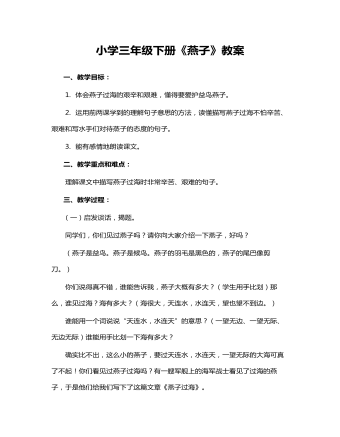
小学三年级下册《燕子》教案
一、教学目标:1. 体会燕子过海的艰辛和艰难,懂得要爱护益鸟燕子。2. 运用前两课学到的理解句子意思的方法,读懂描写燕子过海不怕辛苦、艰难和写水手们对待蒸子的态度的句子。3. 能有感情地朗读课文。二、教学重点和难点:理解课文中描写燕子过海时非常辛苦、艰难的句子。三、教学过程:(一)启发谈话,揭题。同学们,你们见过燕子吗?请你向大家介绍一下燕子,好吗?(燕子是益鸟。燕子是候鸟。燕子的羽毛是黑色的,燕子的尾巴像剪刀。)你们说得真不错,谁能告诉我,燕子大概有多大?(学生用手比划)那么,谁见过海?海有多大?(海很大,天连水,水连天,望也望不到边。)谁能用一个词说说“天连水,水连天”的意思?(一望无边、一望无际、无边无际)谁能用手比划一下海有多大?确实比不出,这么小的燕子,要过天连水,水连天,一望无际的大海可真了不起!你们看见过燕子过海吗?有一艘军舰上的海军战士看见了过海的燕子,于是他们给我们写下了这篇文章《燕子过海》。教师范读(二)学生质疑。读了这篇课文你有什么问题呢?(燕子为什么要过海?为什么它要不分昼夜地飞?为什么像雨点一样落下来?)
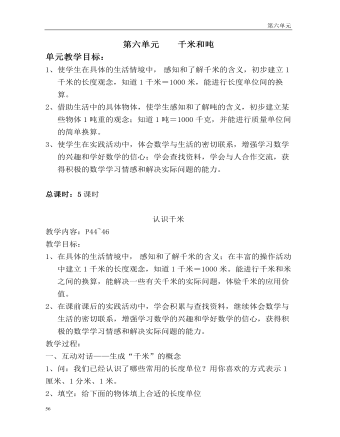
数学三年级下册教案
参与实践,充分体验1、直观感知,初步认识吨让学生说说自己的体重,请出4个体重大约25千克的同学站在一起。算一算4个学生的体重大约是多少千克。再推算一下40个这样的同学大约重多少千克?讲述:为了简便计算1000千克,我们把1000千克规定为1吨。吨也可以用英文字母“t”表示。2、结合实际,进一步认识吨我们教室里的桌、椅、书本等,你认为用吨做单位合适吗?你认为多少张桌子或者椅子合在一起大约重1吨?学生独立思考;引导学生在小组内展开讨论;小组汇报讨论结果;问:在生活中,你见过哪些物体是用吨做单位的?学生举例。讲述:计量比较重或大宗物品有多重时,通常用吨做单位。练习:1棵白菜重1千克,( )棵白菜重1吨。 1袋大米重100千克,( )袋大米重1吨。 1头奶牛重500千克,( )头奶牛重1吨。 1桶油重200千克,( )桶油重1吨。
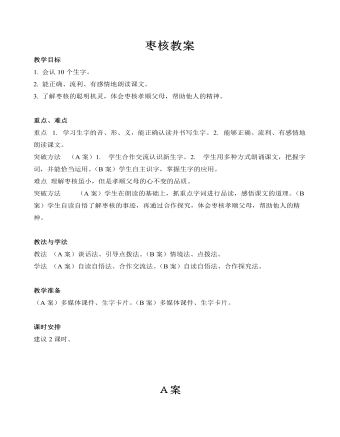
三年级下册《枣核》教案
精读课文,指导阅读1. 理解课文第1自然段。 (1)教师指名读,思考:这一个自然段讲了什么?(了解枣核出生的原因) (2)齐读第1自然段。2.理解第2~4自然段。 (1)理解:一年又一年,枣核一点儿也不见长,父母忧愁的原因。 (2)默读第2自然段,思考。(要给学生充分的时间读书、思考。为第3、4自然段的学习打下基础。) (3)自读第3~4自然段,回答问题。 ①枣核为什么让父母不用担心? ②枣核能做什么? ③大旱时发生了什么事? ④学生齐读。 ⑤提问:这一部分重点写了哪些方面?3.学习第5~13自然段。 (1)理解:大旱后,县衙门做了什么事?枣核又是怎么做的? (2)学生默读,思考。小组讨论、交流。 (3)全班交流,进一步深入理解。枣核的做法说明了什么?(联系上文,回答问题)而对枣核的决定,大家是怎样的态度?面对别人的不信任,枣核做出了怎样的选择?(板书:不争辩,靠行动说话)
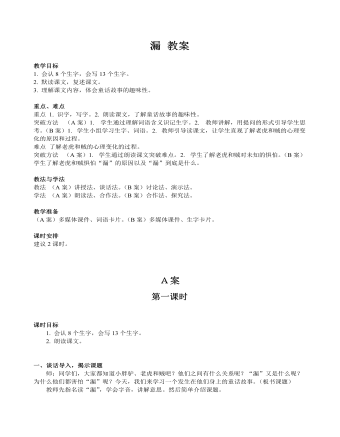
三年级下册《漏》教案
细读课文学生读课文,想想:“漏”指的是什么?学生自读、交流。1. 细读第1~5自然段。 (1)教师指名读,引导学生思考:这几个自然段主要告诉了我们什么? 师:“漏”指的是谁?老婆婆为什么说“什么都不怕,就怕漏”? (2)教师指导朗读。 教师指名试读,学生自由练读,最后集体齐读。2. 学习第6~18自然段。 (1)学生自由读课文,想想这些自然段讲了一个什么故事。 (2)教师指导朗读。学生自由练读,最后集体齐读。 (3)教师指名读选段,让学生说说老虎和贼之间发生了什么,为什么会出现这种情况。3. 学习第19~20自然段。 (1)教师指名读,要求学生思考:这两个自然段告诉了我们一件什么事? (2)天亮了,结果怎么样?(3)教师引导学生感受童话故事,体会其乐趣。
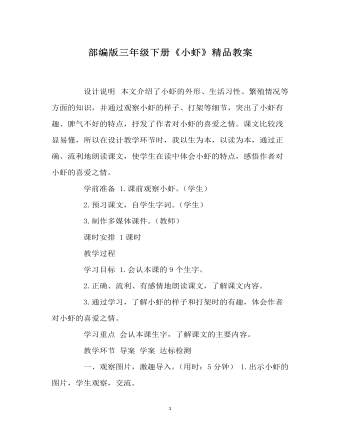
三年级下册《小虾》教案
◆观察细致,描述具体。(教学重点) 师:请同学们认真读一读第三自然段,思考:这一段是围绕哪句话来写的? 生1:这个自然段是围绕“缸里的小虾十分有趣”这一句来写的。 师:说得对。那么,作者是怎样描写小虾的有趣的? 生2:作者用“有的……有的……有的……”这样一个排比句写出了小虾在缸里不同的状态。 生3:作者观察了活动的小虾和休息的小虾不同的表现。 师:说得很好。那休息的小虾和活动的小虾有怎样的表现呢? 生1:休息的小虾受到打扰时会很生气。作者观察很细致,用“一张一张、一翘一翘、一突一突”这些词语写出了小虾生气时的表现,很有趣。

一年级数学下册教案
教学目标:1、通过观察实物,体会到从不同角度观察物体所看到的形状可能是不同的。2、会辨认简单物体从不同角度观察到的形状,发展空间观念。教学重点:会辨认简单物体从不同角度观察到的形状。教学难点:体会到从不同角度观察到的的形状可能是不同的,发展空间观念。课前准备:实物或图片等教学过程:一、出示玩具汽车,学会观察物体第一步:1、观察玩具汽车,学生分别站在汽车侧面和后面两个不同的方向观察。2、分别把玩具汽车的侧面和后面对着全班,让学生说一说这是谁看到的?3、小结:不同的位置观察同一物时,看到的形状可能是不同的。
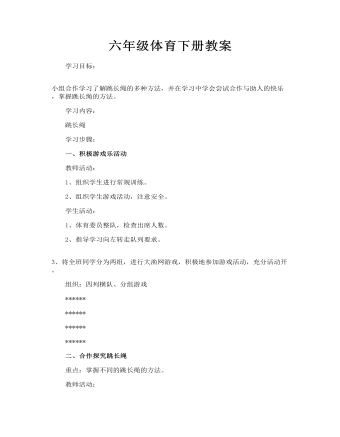
六年级体育下册教案
一、积极游戏乐活动 教师活动: 1、组织学生进行常规训练。 2、组织学生游戏活动,注意安全。 学生活动: 1、体育委员整队,检查出席人数。 2、指导学习向左转走队列要求。
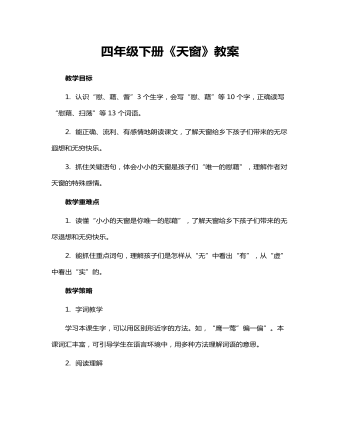
四年级下册《天窗》教案
教学目标1. 认识“慰、藉、瞥”3个生字,会写“慰、藉”等10个字,正确读写“慰藉、扫荡”等13个词语。2. 能正确、流利、有感情地朗读课文,了解天窗给乡下孩子们带来的无尽遐想和无穷快乐。3. 抓住关键语句,体会小小的天窗是孩子们“唯一的慰藉”,理解作者对天窗的特殊感情。教学重难点1. 读懂“小小的天窗是你唯一的慰藉”,了解天窗给乡下孩子们带来的无尽退想和无穷快乐。2. 能抓住重点词句,理解孩子们是怎样从“无”中看出“有”,从“虚”中看出“实”的。教学策略1. 字词教学学习本课生字,可以用区别形近字的方法。如,“鹰一莺”编一偏”。本课词汇丰富,可引导学生在语言环境中,用多种方法理解词语的意思。2. 阅读理解主要采用提出问题引导阅读的方式教学:先让学生带着疑问读课文,接着细读课文并思考天窗给乡下的孩子带来了什么,然后抓住文章的中心句“小小的天窗是你唯一的慰藉”一句理解课文,最后结合全文内容体会孩子被唤回家时的失落,又从天窗中想象出无穷的情形、故事,找回了失去的快乐。3. 表达运用运用读写结合的策略,学习课文后,启发学生结合自己的生活实际谈感受,写感受。教学准备1. 预习提纲:完成《状元大课堂·好学案》对应课文预习作业。2. 准备资料:多媒体课件。教学课时:2课时第1课时,课时目标:1. 认识“慰、藉、瞥”3个生字,会写“慰、藉”等10个字,正确读写“慰藉、扫荡”等13个词语。2. 能正确、流利地朗读课文,整体感知课文主要内容,理清课文脉络。教学过程板块一,设疑激趣,导入新课。1. 导入新课。(1) 课件出示天窗图片。(2) 师引导:同学们,你们知道这是什么吗?(3) 了解课文题目。师板书课题:天窗;指名读课题。(4) 设置疑问。师引导:看到课题,同学们有什么想问的吗?(示例:什么是天窗?)
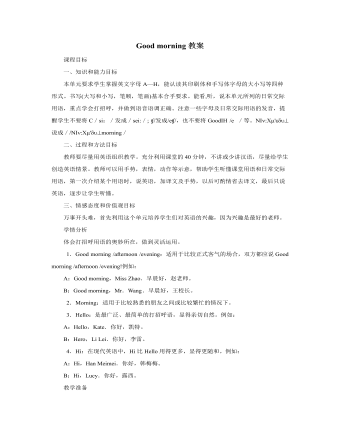
人教版新目标初中英语七年级上册Good morning教案
一、知识和能力目标本单元要求学生掌握英文字母A—H,能认读其印刷体和手写体字母的大小写等四种形式。书写(大写和小写,笔顺,笔画)基本合乎要求。能看,听,说本单元所列的日常交际用语,重点学会打招呼,并做到语音语调正确。注意一些字母及日常交际用语的发音,提醒学生不要将C/si:/发成/sei:/; ?/发成/e?/,也不要将Good?H /e /等。??????'????说成/???????'???morning/二、过程和方法目标教师要尽量用英语组织教学。充分利用课堂的40分钟,不讲或少讲汉语,尽量给学生创造英语情景。教师可以用手势,表情,动作等示意,帮助学生听懂课堂用语和日常交际用语,第一次介绍某个用语时,说英语,加译文及手势,以后可酌情省去译文,最后只说英语,逐步让学生听懂。
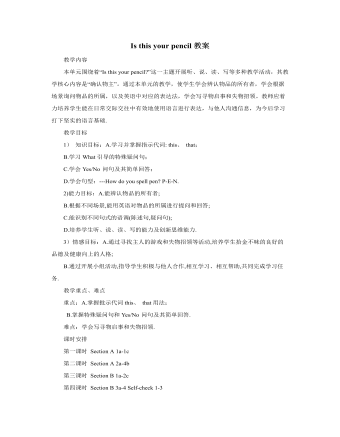
人教版新目标初中英语七年级上册Is this your pencil教案
T: Please look at the pictures and learn the new words.(用多媒体展示新单词效果较好。)1.at prep. 在(里面或附近);在(点刻);2.theart.表示特指的人、物、事或群体 3.lostadj.丢失的;遗失的4.Found adj. (find的过去式、过去分词)找回的5.lost and found 失物招领6.please adv.请7.school n. 学校8.a set of一套;一副(Teach students to read the words.)2. Practice the new words. (事先录制一段短的听力,让学生通过听的训练来强化所学的新单词,并为学习写寻物启示和失物招领作好准备。)T: Please listen to a short passage twice then fill the blanks using the words we learned.(Show students a short passage and play the recording for the students to listen.)There are many things in (1)_____________________in my (2)__________. Look, here’s (3)_________keys. Is this yours? (4)__________call Jim (5)___________753-2289.Typescript:There are many things in the Lost and Found in my school. Look, here’s a set of keys. Is this yours? Please call Jim at 753-2289.
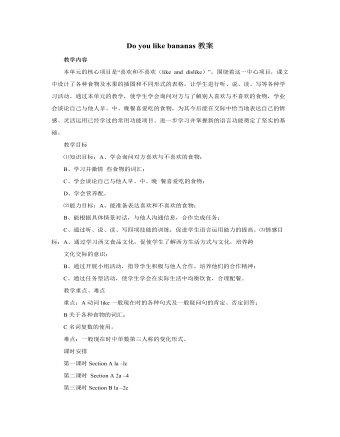
人教版新目标初中英语七年级上册Do you like bananas教案
教学目标 ⑴知识目标:A、学会询问对方喜欢与不喜欢的食物; B、学习并激情 些食物的词汇; C、学会谈论自己与他人早、中、晚 餐喜爱吃的食物; D、学会营养配。 ⑵能力目标:A、能准备表达喜欢和不喜欢的食物; B、能根据具体情景对话,与他人沟通信息,合作完成任务; C、通过听、说、读、写四项技能的训练,促进学生语言运用能力的提高。⑶情感目标:A、通过学习西文食品文化,促使学生了解西方生活方式与文化,培养跨 文化交际的意识; B、通过开展小组活动,指导学生积极与他人合作,培养他们的合作精神; C、通过任务型活动,使学生学会在实际生活中均衡饮食,合理配餐。 教学重点、难点 重点:A动词like一般现在时的各种句式及一般疑问句的肯定、否定回答; B关于各种食物的词汇; C名词复数的使用。 难点:一般现在时中单数第三人称的变化形式。
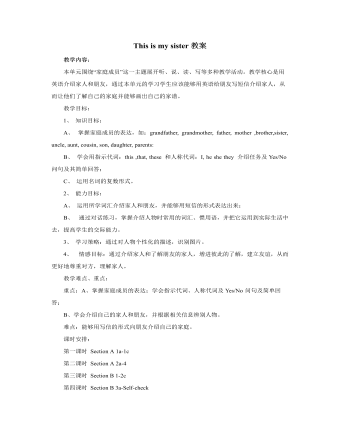
人教版新目标初中英语七年级上册This is my sister教案
(Play the recording twice again.) (Check the answer.) ③Pairwork. Draw your own picture and talk about it. T: We find out the picture of Lin Hai’s family. Can you draw a picture of your family? SS: … T: OK. When you finish drawing, tell your partner about your picture. You can use “This is …” and “ These are …” to talk about. Then report it to the class. (Students work.) (Check students’ work. Ask two or three students to report.) Step Three: Task. Talk about the family tree. T: Look at the family tree. I think it’s a big family. You can do it in groups of four or three. You can do it in pairs or only by yourself. Then report it to the class. (Students work. Teacher walks around in the classroom and helps the students.) T: Stop here. Let’s check it out. (Choose students to do it.) S1: Look at my family tree. This is my… This is my … They have two … This is my … This is my …This is my …This is my. My parents have two children. This is…This is my …My uncle and my aunt have a son. He is my … (Ask two more students to do it.) Homework. Write a passage about your family.
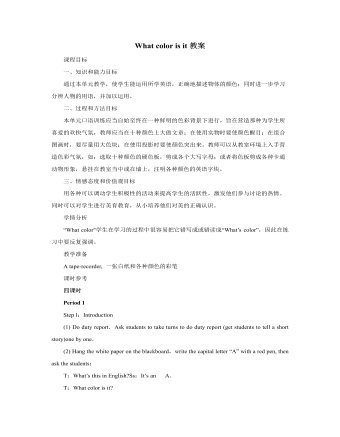
人教版新目标初中英语七年级上册What color is it教案
一、知识和能力目标通过本单元教学,使学生能运用所学英语,正确地描述物体的颜色;同时进一步学习分辨人物的用语,并加以运用。二、过程和方法目标本单元口语训练应当自始至终在一种鲜明的色彩背景下进行,旨在营造那种为学生所喜爱的欢快气氛,教师应当在十种颜色上大做文章;在使用实物时要使颜色醒目;在组合图画时,要尽量用大色块;在使用投影时要使颜色突出来。教师可以从教室环境上入手营造色彩气氛,如:选取十种颜色的硬色板,剪成各个大写字母;或者将色板剪成各种卡通动物形象,悬挂在教室当中或在墙上,注明各种颜色的英语字块。三、情感态度和价值观目标用各种可以调动学生积极性的活动来提高学生的活跃性,激发他们参与讨论的热情。同时可以对学生进行美育教育,从小培养他们对美的正确认识。
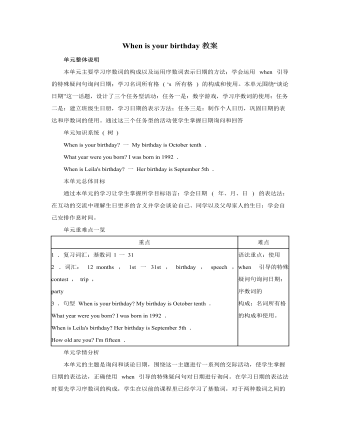
人教版新目标初中英语七年级上册When is your birthday教案
本单元主要学习名词所有格 ('s 所有格 ) 的构成和使用。在初次接触 “ 名词所有格 ” 时,学生较难理解的可能是 “ 所有格 ” 这个名称,对于它的构成,学生也许会觉得较容易。教师可通俗地告诉学生 “ 所有格 ” 的意思是表示 “…… 的 ” ,这样学生反而容易接受。在使用 “ 名词所有格 ” 形式时,学生容易犯错误或混淆的主要是:将这种一 's 构成形式与 is 的缩写形式混淆,如: My father's name's Jin Zhi .,可以这样告诉学生:名词所有格的后面一般应接名词;勿将这种一 's 结构盲目套用与人称代词上,代替物主代词使用,如 He's father's name is Li Cheng 。在教学初期,可不讲授名词所有格的其它形式,待时机成熟,再向学生介绍复数名词所有格形式的结构一 ' ,如: the students' bikes 。 Self Check 教学内容 Self Check( 教材 P52) 教学目标 知识与能力 复习词汇 birthday , date , month , January , February , March , April , May , June , July , August , September , October , November , December , date , birth , age , old , speech . contest . trip , party , event , an , festival , pop , concert , chorus , lecture , music ;引导学生复习、巩固“询问和谈论日期”的目标语言并运用所学知识安排活动。

